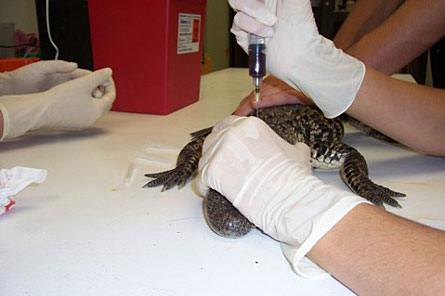New money for undergraduate research
Profs who want to push science beyond the classroom have a strong ally: the Tucson, Ariz.-based Research Corporation for Science Advancement. In about a month, it will begin issuing requests for proposals to launch a new type of grants for pre-tenure faculty at predominantly undergraduate institutions, also known as PUIs. The program is open to teams of two or more scientists to mentor cross-disciplinary research.

By undergraduates. We’re talking teenagers, here.
Back in my day, undergrads might contribute some grunt labor to a prof’s project, but we weren’t the principle researchers. And we labored anonymously. The big exception: engineering students doing co-op stints in industry.
But the times, they are a-changin’.
At 19, my daughter was learning lab techniques and doing field work as part of a research team at Florida on gators. A year later, she was doing 95 percent of the research for an inorganic-chemistry project that should yield her first-authorship on a peer-reviewed paper — potentially by the time she graduates.
“Undergraduate research is starting to become almost a staple at many of the better institutions,” notes James M. Gentile, a genetic toxicologist and president of Research Corp. That’s certainly true at a number of research universities. His organization has been sponsoring grants for undergraduate research at much smaller schools since the end of World War II.
That program “was initially chartered by our founder to help young men coming home from war reestablish themselves in the sciences at smaller institutions,” Gentile notes. But for quite a while, now, the program also has been available to female faculty and students — like those at the predominantly undergraduate women’s college my daughter attends.
Predominantly, in this case, refers to schools that don’t have Ph.D. programs in the physical sciences. And Gentile’s organization now offers between 75 and 90 grants at a time to individual young investigators at such schools. Beginning this year, the program will grow to include perhaps another dozen teams of young investigators at these institutions.
Three-year grants will provide $75,000 to pairs of faculty or $100,000 to trios. Where a trio is selected, one scientist may be tenured. In all cases, at least one member of the team must work in physics, chemistry or astronomy. Co-recipients of the grant must work in allied fields, although not necessarily the physical sciences. A partnering researcher could be a mathematician, for instance, or biologist.
The goal is to “fund what we hope will be a young faculty’s entry-level grant into the world of research,” Gentile says, “because we believe that the best educators at PUIs are those who are engaged in the discipline they’re teaching.” Gentile says he witnessed that trend first hand during his years as dean at a PUI — Hope College in Holland, Mich. And soon-to-be unpublished research, he says, will “statistically validate that the students who do undergraduate research are actually your best learners.”
Maybe because their hands-on science — work for which they take ownership of all accomplishments, and failures — cements the scientific method into their skulls. It also teaches them what kinds of questions and criticisms to anticipate from peers and professors — and therefore what kinds of homework and analysis to complete before showcasing their findings.
Research Corp.’s newest program focuses on interdisciplinary research “because increasingly science, particularly complex science, is becoming a tag-team sport,” Gentile says. So is teaching. “There’s not a college or a university that I know that doesn’t boast with justifiable pride that they’re forming or have formed interdisciplinary education programs in the sciences,” he says.
Yet faculty often “aren’t rewarded when they do collaborative research,” he maintains — unless they’re the principal investigator who brought in the funds. That’s one reason why Research Corp. grants money collectively to an entire team. All receive equal credit.
Started in 1912, Research Corporation for Science Advancement is the nation’s first foundation dedicated solely to science and the second oldest of any type. Haven’t heard of it before? “You’re not alone,” Gentile admits: “For a long time, it just conducted quiet philanthropy.”
And that funding will continue, even in this sick economy. “I’ve argued — and our board agrees — this isn’t a time to hunker down. It’s a time to double-down, to get aggressive and help the community,” he told me. So his organization will be upping its spending on research in the coming year, not cutting back.






